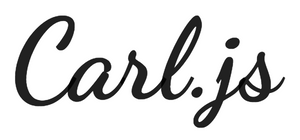If your lazy but efficient and want just one place where you can manage what css, javascript or even html resources are loaded, depending on wheather are not they are actually needed, then maybe Carl.js is for you.
Carl.js works in two parts; Running tests and loading resources.
The tests and resources are defined like so "test" : [ "array of resources to load if test is passed" ] - these can be placed in an external resources.json which is located at the root of your project (or elsewhere if you want) or they can be bundled together with the carl.js script.
this is an example of a resources.json
{
".amazing-carousel" : [
"css/carousel.css",
"js/carousel.js"
],
".no-objectfit" : [
"js/object-fit-polyfill.js"
]
}So basically whats happening here is that if the class amazing-carousel is found in the DOM, then the carousel resources carousel.css and carousel.js will be loaded. Also if the class no-objectfit is found, then the object-fit-polyfill.js will be loaded
You aren't just limited to classes. You can also use id's, plain tag names or even data-attribute selectors. Basically any valid css selector that would work in a querySelector(), like so
{
"form" : [
"css/form.css",
"js/form-validator.js"
],
"#home-page" : [
"css/home-page.css"
],
"[data-table-sorter]" : [
"js/table-sorter.js"
],
"pre > code": [
"css/github-syntax-highlighting.css",
"js/highlight.pack.js"
],
"html:not(#contact-page)" : [
"css/every-page-but-contact-page.css"
]
}As well as testing for css selectors, you can also test window objects, like window.something. So, for example, if you wanted to test if the browser supports scroll snap points using Modernizr
{
"Modernizr.scrollsnappoints" : [
"css/cool-scroll-snap-stuff.css"
]
}or, like the object-fit example, to load a fallback/polyfill if the test returns false use !
{
"!Modernizr.cssgrid" : [
"css/flexbox-fallback.css"
]
}or use the !! to test if a window object is undefined or falsey
{
"!!dataLayer" : [
"js/some-google-analytics-script.js"
]
}You can also use Carl.js to load snippets of html, like a footer for example.
{
"footer.main-footer" : [
"components/footer.html"
]
}and the html resource will replace the DOM element that returned true for the test
<footer class="main-footer"></footer>
<!-- this will be replaced with the contents of footer.html -->NOTE: For loading html conditionally the test must be a selector test and not a window.object test. This is because the html resource replaces the DOM element that "passed" the test.
Just include the resources.json in the root of your project and place the carl.min.js file just before the closing body tag on every page like so.
<script src="js/carl.min.js"></script>
</body>and your good to go. Start adding your tests and resources in the resources.json
Since the script is very small you might want to just include the resources.json directly inside Carl.js. This will be more efficient since it cuts out one request for the resources.json Use the carl.bundle.js for this, and include it just before the closing body tag instead of carl.min.js
Yes, until the resource is loaded the html will be seen unstyled. You could get around this by hiding the html, then loading a small piece of css thet unhides it.
{
"html" : [
"css/unhide-the-page.css"
]
}If the resource is only a few bytes of css like h1.big { font-size: 5rem; line-height: 1.2 } then it's not really worth creating a test just for that. Any resource that is over 1kb is ok to load conditionally.
Hopefully Yes! If you are suffereing from css bloat ie. you have a 500kb css file that is loaded on every page. It would make sense to componentize it, and load it only when needed. This will cut down your file size and it should also make maintaining it easier.
Also if you have some html which is the same on every page (like the header, footer and sidebar) Then loading them as components will force the browser cache them, so when a user browsers your site these html resources will be loaded instantly and the html pages will be smaller.
The carl.min.js is loaded once just before the closing body tag, so any css selectors or window objects would have to be already present in the DOM. The script can of cource be called again as a callback after you've loaded your dynamic content, then all the tests would be ran again.
Yes. Any script that is included in a html resource (like the footer.html) will be executed
You would need to include the script inside the html resource to absolutely gaurentee that it is loaded after the html has been added to the DOM.
Ajax is Asyncronous (its what the "A" stands for). Because of this there is no gaurantee that one resource is loaded before the other, so rather than doing this...
{
"footer.main-footer" : [
"components/footer.html",
"js/footer-script.js",
"css/footer-styles.css"
]
}Do this...
<!-- footer.html -->
<link rel="stylesheet" href="css/footer-styles.css" >
<div>
<p>Copyright 2020<p>
<div>
site map, social media, contacts etc...
</div>
</div>
<script src="js/footer-script.js"></script>Even better would be to inline the scripts and styles to reduce http requests (since footer.html will be cached anyway)
<!-- footer.html -->
<style>
/* contents of footer-styles.css */
</style>
<div>
<p>Copyright 2020<p>
<div>
site map, social media, contacts etc...
</div>
</div>
<script>
/* contents of footer-scripts.js */
</script>You could, but Carl.js wasn't really built for that purpose. If you want to do that kind of thing then maybe consider using react or some other MVC framework.
These days Google will respect content loaded via ajax, so it really shouldn't be a problem. You might not want to put facebook or twitter meta content in a html component, since their bots will not respect the ajax content.

